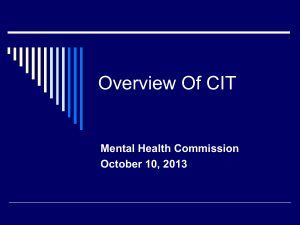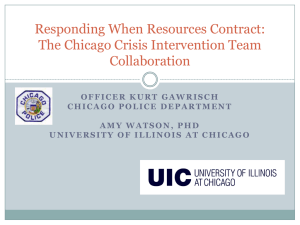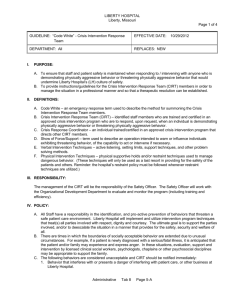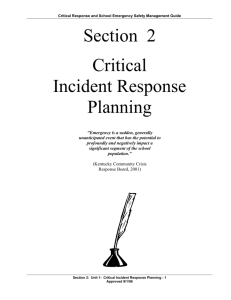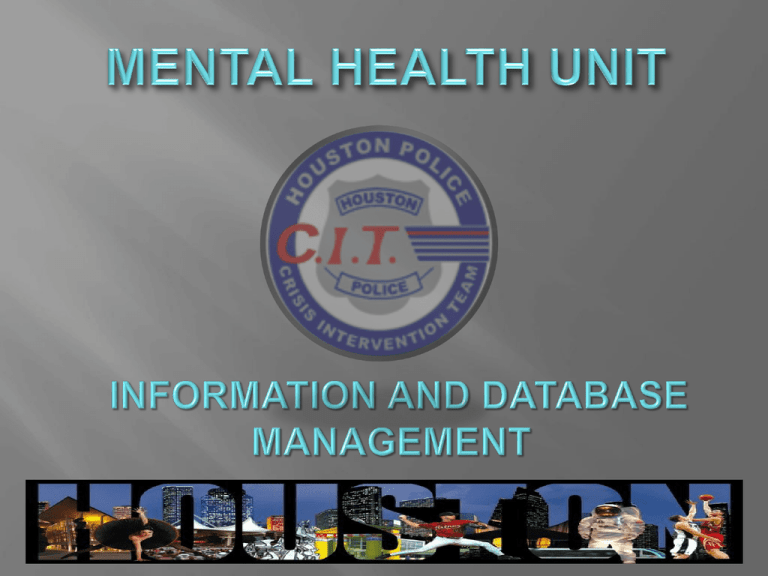
1
Brief historical perspective prior to CIT program
Inception of the CIT program and how it evolved into the
Mental Health Unit
Unit organization chart
How the creation of a CIT database benefits our police
department
Implementing your own CIT Tracking Program
Information management
2
City of Houston Population:
2,100,000
HPD Calls for Service:
1,145,734
CIT Calls for Service:
25,500
CIT Offense Reports:
11,528
Total CIT Reports Catalogued:
8,270
Total HPD Officers:
5,300
Total CIT Officers:
1,848
Total CIT Cases Investigated by MHU:
1,155
Total Mental Health Unit (MHU) Investigative Staff:
5
3
1991- Impetus for Working on Mental Health Issues
•
•
•
The process of obtaining an emergency detention order
was very complicated and time consuming
Officers spent on average 5 to 6 hours filing 7 pages of
affidavits, locating a judge, a notary, and a hospital bed.
Only one hospital facility available with 12 beds – limited
area resources for law enforcement to utilize
1992 – The Roots of inter-agency collaboration & CIT
•
•
One officer took initiative and met with MHMRA director
to streamline the EDO process and reduce time
Developed plans for a future facility that would handle
consumers brought in by police in a timely manner
4
1993 – First Class on Mental Illness
•
•
•
•
•
Prior to the 1990’s there was no formal training available
for police officers regarding different mental disorders
No tactics or techniques for crisis de-escalation
available for officers dealing with individuals with serious
mental health crises
Officers had mostly negative attitudes about mental
illness and the lengthy, time consuming process of
obtaining an emergency detention order
Most officers did not feel responding to individuals with
mental illness was role of law enforcement
Officer Frank Webb and Dr. Schnee developed 8 hour
in-service class ‘Dealing with the Mentally Ill’
5
1996 – Mandatory 16 hour class for Patrol Sergeants
•
Chief Nuchia approved and mandated 16 hours of
training regarding mental health issues for all patrol
sergeants.
1998 – Harris County Criminal Justice Workgroup
•
•
•
A multi-agency workgroup was formed to address
barriers to responding to the mentally ill in Harris
County.
Committee decided primary issue to address was the
law enforcement’s response to individuals in serious
crisis situations.
This paved the way for the development of the CIT
program in the Houston Police Department.
6
1999 – CIT 6 month pilot program
•
•
•
•
•
40 hour class taught by Officer Frank Webb.
Program was voluntary and offered to patrol
63 patrol officers became CIT trained
Opening of the Neuro-Psychiatric Center (NPC)
Average time on EDO – 15 minutes
2000 – Department-wide Implementation
•
213 patrol officers trained.
2001 – CIT Coordinator Position Approved
•
•
Over 700 officers have received training
This position reported directly to Executive Assistant
Chief over Patrol Operations
7
2005 – State Mandated CIT training; Senate Bill 1473
•
Senate Bill 1473 mandates 16 hours of CIT and deescalation training for all Texas peace officers.
2006 – CIT Administrative Unit formed
•
The size and complexity of Houston’s CIT program,
along with increased training responsibilities related to
Senate Bill 1473, resulted in a program too large for one
person (Senior Officer Frank Webb) to coordinate. Chief
of Police Harold L. Hurtt approved the formation of a CIT
administrative unit in August 2006.
8
2007 – Formation of the Mental Health Unit
•
The CIT program is the foundation of the unit
•
This unit oversees the department’s multi-faceted,
comprehensive program for responding to
individuals in serious mental health crisis
•
Programs under this unit include the following:
1)
2)
3)
4)
5)
6)
Administration & CIT Training Unit
Investigations
Crisis Intervention Response Team (CIRT)
Chronic Consumer Stabilization Initiative (CCSI)
Homeless Outreach Team (HOT)
Sobering Center (January 2013)
9
a)
A peace officer, without a warrant, may take a person into custody if the officer:
1) has reason to believe and does believe that:
A. the person is mentally ill; and
B. because of that mental illness there is a substantial risk of serious harm to the
person or to others unless the person is immediately restrained; and
2) believes that there is not sufficient time to obtain a warrant before taking the person
into custody.
b)
A substantial risk of serious harm to the person or others under Subsection (a)(1)(B) may
be demonstrated by:
1) the person's behavior; or
2) evidence of severe emotional distress and deterioration in the person's mental
condition to the extent that the person cannot remain at liberty.
(c)
The peace officer may form the belief that the person meets the criteria for apprehension:
1) from a representation of a credible person; or
2) on the basis of the conduct of the apprehended person or the circumstances under
which the apprehended person is found.
10
4
INCIDENT REPORTS
Officers will complete an incident report on
all incidents involving persons suspected of
mental illness. The title of the report will be
the same as the offense. If no criminal
offense was committed, the offense report
will be titled Investigation-Mental Illness.
The report will include the name of the
psychiatrist who examined the person
suspected of mental illness
11
12
Lieutenant M. A. Lee
Mental Health Unit
Sergeant M. Loera
Sergeant P. Plourde
Sergeant J. Ramirez
Sergeant S. Wick
INVESTIGATIONS
CIRT
CIRT
HOMELESS OUTREACH
SPO M. Rubin
PO R. Arias
PO M. Stevens
SPO J. Giraldo
Investigator
CIRT Officer
CIRT Officer
H.O.T. Officer
SPO D. Anders
SPO J. Osborne
PO J. Llorente
PO J. Terry
CIRT Officer
CIRT Officer
H.O.T. Officer
PO P. Rayon
PO N. Baines
PO J. Garcia
Investigator
CIRT Officer
CIRT Officer
PO M. Pate
PO R. Dunn
PO R. Conchola
Investigator
CIRT Officer
CIRT Officer
SPO F. Webb
PO C. McKinney
PO S. Augustine
Training
CIRT Officer
CIRT Officer
PO R. Skillern
PO C. Vaughan
Training
Training
Investigator
13
Define it’s purpose
Information source – offense reports, calls for service
Type of data collected
How will the information collected be used
Investigations and follow-ups
Research and analysis – Response strategies
Statistics
14
Proper Dispatch Call Codes and Titles
a) Non-Family Disturbance/CIT
b) Suspicious Person/CIT
Proper Offense Report Titles
a) Investigation Mental Illness (CIT)
b) Harassment (CIT)
c) Trespassing (CIT)
15
16
17
The initial steps to help identify who your mental health
clients are within your jurisdiction starts with a
thorough screening procedure
a) Source of information:
Offense Reports
A report screener reviews every printed offense report
that has been coded ‘CIT’ and makes notations of all
relevant mental health components and major
indicators that were documented by the patrol officer at
the scene
18
Filtering out the major indicators and mental health
components from a police report will be crucial when
collecting this information and imputing this into a
comprehensive database (Statistics)
Examples of Mental Health Components and Major Indicators:
Delusional
Paranoia
Hearing Voices
Suicidal
Homicidal
Off Medication
Violence/Threat
Weapons used
Use of Force
Request Suicide by cop
Suicide Attempt/Method
Jail Diversion
19
20
OFFENSE
REPORT
Lieutenant M. A. Lee
Mental Health Unit
SPO M. Rubin
Sergeant M. Loera
Investigator
Investigative Supervisor
INVESTIGATIVE
ASSIGNMENTS
PO P. Rayon
PO M. Pate
SPO D. Anders
Investigator
Investigator
Investigator
DATABASE
ENTRY
21
Mental health consumers who were reported to be in a
mental health crisis and met the criteria for an
Emergency Detention Order (EDO)
Mental health consumers who were reported to have
committed a criminal offense or were likely to have
committed a criminal offense due to their untreated or
uncontrolled psychotic behavior
Known mental health consumers who pose a danger
or serious threat to themselves or the public
22
23
24
25
Critical information gleaned from the CIT database can
be shared with segments of the law enforcement
community and the local police department under
specific circumstances:
1)
2)
3)
Safety awareness to first responders
Safety alert bulletins disseminated to the
appropriate Patrol Division or Precinct where the
mental health consumer resides
Premise histories on certain locations issued to the
Emergency Communications Division (Dispatcher)
26
27
28
29
30
The database is not a department wide program and
it cannot be accessed by anyone outside the agency
Maintained on secure server
31
900 to 1000 offense reports (CIT) are reviewed each
month
75 to 125 cases are assigned to all 4 investigators
each month
Such cases include:
a)
b)
c)
d)
e)
Criminal charges on serious offenses
Firearms investigations
Premise histories on locations or persons with serious
mental illness who engaged in violent behavior
Chronic consumers involving numerous contacts with
the police
Referrals
32
Properly reviewed offense reports are developed into
case files and are assigned for follow-up investigations
or referred to outside agencies for appropriate
handling. Some examples are the following:
a)
b)
c)
d)
e)
Child Protective Services (CPS)
Adult Protective Services (APS)
Department of Public Safety (DPS)
Mobile Crisis Outreach Team (MCOT)
Crisis Intervention Response Team (CIRT)
33
34
35
36
All files and records are retained solely within the
police department’s Mental Health Unit.
Access is only authorized to investigators and
supervisors assigned within the Mental Health Unit.
37
38
39
40
41
42
43
C.I.T. INCIDENTS
TOTAL CIT CALLS FOR SERVICE
TOTAL CIT REPORTS REVIEWED
2007
2008
2009
2010
2011
15,122 21,109 23,913 25,105 24,771
N/A
N/A
6503 10628 11528 -
2007/2008 2008/2009 2009/2010 2010/2011
% CHANGE % CHANGE % CHANGE % CHANGE
39.6%
13.3%
5.0%
-
-
63.4%
-1.3%
8.5%
2102
3642
4811
7024
8270
73.3%
32.1%
46.0%
17.7%
N/A
N/A
N/A
1514
1155
-
-
-
-23.7%
1254
2112
2699
3822
4580
68.4%
27.8%
41.6%
19.8%
846
1528
2106
3115
3696
80.6%
37.8%
47.9%
18.7%
WHITES (TOTAL)
635
1120
1735
3014
3233
76.4%
54.9%
73.7%
7.3%
WHITE MALES
398
606
966
1634
1795
52.3%
59.4%
69.2%
9.9%
WHITE FEMALES
237
514
769
1380
1438
116.9%
49.6%
79.5%
4.2%
BLACKS (TOTAL)
1113
1843
2225
3223
3711
65.6%
20.7%
44.9%
15.1%
BLACK MALES
636
1094
1250
1782
2020
72.0%
14.3%
42.6%
13.4%
BLACK FEMALES
477
749
975
1451
1691
57.0%
30.2%
48.8%
16.5%
HISPANICS (TOTAL)
305
604
680
521
1125
98.0%
12.6%
-23.4%
115.9%
HISPANIC MALES
188
370
386
324
682
96.8%
4.3%
-16.1%
110.5%
HISPANIC FEMALES
117
234
294
197
443
100.0%
25.6%
-33.0%
124.9%
ASIANS (TOTAL)
45
66
109
158
181
46.7%
65.2%
45.0%
14.6%
ASIAN MALES
30
35
60
75
76
16.7%
71.4%
25.0%
1.3%
ASIAN FEMALES
15
31
49
83
105
106.7%
58.1%
69.4%
26.5%
OTHERS (TOTAL)
3
3
62
5
5
0.0%
1966.7%
-91.9%
0.0%
TOTAL REPORTS CATALOGUED
TOTAL CASES INVESTIGATED
TOTALS BY GENDER
MALES
FEMALES
TOTALS BY SEX/RACE
AGE GROUPS
2007/2008 2008/2009 2009/2010 2010/2011
% CHANGE % CHANGE % CHANGE % CHANGE
2007
2008
2009
2010
2011
16 - 19
73
135
178
241
301
84.9%
31.9%
35.4%
24.9%
20 - 29
467
786
999
1493
1742
68.3%
27.1%
49.4%
16.7%
30 - 39
336
572
805
1115
1191
70.2%
40.7%
38.5%
6.8%
40 - 49
387
655
748
918
1157
69.3%
14.2%
22.7%
26.0%
50 - 59
205
387
549
883
941
88.8%
41.9%
60.8%
6.6%
60 - 69
58
96
153
226
330
65.5%
59.4%
47.7%
46.0%
70 - 79
17
37
44
114
110
117.6%
18.9%
159.1%
-3.5%
80 - 89
0
0
0
0
50
-
-
-
-
90 - 99
0
0
0
0
10
-
-
-
-
-
JUVENILES
8.2%
JUVENILE MALES
51
108
122
217
262
111.8%
13.0%
77.9%
20.7%
JUVENILE FEMALES
35
98
114
197
211
180.0%
16.3%
72.8%
7.1%
0
0
0
0
2
-
-
-
-
TASER INCIDENTS
19
33
26
30
30
73.7%
-21.2%
15.4%
0.0%
REQUEST SUICIDE BY COP
40
44
47
82
77
10.0%
6.8%
74.5%
-6.1%
SWAT INVOLVED INCIDENT
5
10
10
9
9
100.0%
0.0%
-10.0%
0.0%
THREAT OF VIOLENCE
780
153
741
1237
782
-80.4%
384.3%
66.9%
-36.8%
WEAPONS INVOLVED
228
25
262
317
221
-89.0%
948.0%
21.0%
-30.3%
FIREARMS INVESTIGATIONS
N/A
N/A
N/A
N/A
83
-
-
-
-
ILLEGAL DRUG USE / ALCOHOL
231
371
484
337
493
60.6%
30.5%
-30.4%
46.3%
COMPLETED SUICIDES
MAJOR CATEGORIES
REPORTED DIAGNOSES
2007/2008 2008/2009 2009/2010 2010/2011
% CHANGE % CHANGE % CHANGE % CHANGE
2007
2008
2009
2010
2011
SCHIZOPHRENIA
235
457
634
742
1063
94.5%
38.7%
17.0%
43.3%
BI-POLAR DISORDER
327
620
808
1110
1375
89.6%
30.3%
37.4%
23.9%
MAJOR DEPRESSION
303
593
848
1148
1743
95.7%
43.0%
35.4%
51.8%
PTSD
N/A
N/A
N/A
44
78
-
-
-
77.3%
DEMENTIA
N/A
N/A
N/A
N/A
89
-
-
-
-
HEARING VOICES
317
400
641
940
1099
26.2%
60.3%
46.6%
16.9%
DELUSIONAL
443
932
920
1186
1216
110.4%
-1.3%
28.9%
2.5%
PARANOIA
120
18
167
647
975
-85.0%
827.8%
287.4%
50.7%
SELF MUTILATING
N/A
N/A
N/A
139
181
-
-
-
30.2%
HOMICIDAL
N/A
N/A
N/A
462
584
-
-
-
26.4%
SUICIDAL IDEATIONS
1454
184
1881
257
2208
350
2313
540
57.4%
29.4%
17.4%
4.8%
SUICIDAL THREATS
924
220
-16.4%
39.7%
36.2%
54.3%
SUICIDE ATTEMPTS
182
272
514
1158
1423
49.5%
89.0%
125.3%
22.9%
COMPLETED SUICIDES
N/A
N/A
N/A
62
122
-
-
-
96.8%
OFF MEDICATIONS
667
1160
1393
1677
2172
73.9%
20.1%
20.4%
29.5%
4
46
63
127
168
1050.0%
37.0%
101.6%
32.3%
HOMELESS
189
311
359
528
517
64.6%
15.4%
47.1%
-2.1%
PERSONAL CARE HOMES
107
120
275
233
341
12.1%
129.2%
-15.3%
46.4%
SYMPTOMS/BEHAVIORS
OTHER GROUPS
MILITARY VETERANS
REPEAT CONSUMERS
2007/2008 2008/2009 2009/2010 2010/2011
% CHANGE % CHANGE % CHANGE % CHANGE
2007
2008
2009
2010
2011
CHRONIC CONSUMERS 2X
133
225
228
322
267
69.2%
1.3%
41.2%
-17.1%
CHRONIC CONSUMERS 3X
37
50
52
92
79
35.1%
4.0%
76.9%
-14.1%
CHRONIC CONSUMERS 4X
6
16
19
29
33
166.7%
18.8%
52.6%
13.8%
CHRONIC CONSUMERS 5X
7
11
6
13
16
57.1%
-45.5%
116.7%
23.1%
CHRONIC CONSUMERS 6X
3
3
2
5
7
0.0%
-33.3%
150.0%
40.0%
7X
0
3
2
0
1
-
-33.3%
-100.0%
-
8X
0
1
1
2
1
-
0.0%
100.0%
-50.0%
9X
0
1
0
0
1
-
-100.0%
-
100.0%
10X
0
0
0
1
0
-
-
-
-
11X
0
0
0
0
3
-
-
-
-
12X
0
1
0
2
0
-
-100.0%
-
-100.0%
13X
0
0
0
0
0
-
-
-
-
14X
0
0
0
0
1
-
-
-
-
1959
2688
2604
3617
4198
37.2%
-3.1%
38.9%
16.1%
71
302
805
413
1406
325.4%
166.6%
-48.7%
240.4%
ADMITTED TO V.A. HOSPITAL
4
46
64
144
165
1050.0%
39.1%
125.0%
14.6%
ADMITTED TO ST. JOSEPH’S
N/A
46
73
N/A
16
-
58.7%
-
-
12
126
223
341
138
950.0%
77.0%
52.9%
-59.5%
ADMITTED TO N.P.C.
ADMITTED TO BEN TAUB
OTHER AREA HOSPITALS
JAIL DIVERSIONS /
CRIMINAL OFFENSES
2007/2008 2008/2009 2009/2010 2010/2011
% CHANGE % CHANGE % CHANGE % CHANGE
2007
2008
2009
2010
2011
JAIL DIVERSION TOTALS (DEP’T)
814
1244
1508
2099
1847
52.8%
21.2%
39.2%
-12.0%
JAIL DIVERSION TOTALS (CIRT)
N/A
N/A
N/A
242
614
-
-
-
153.7%
AGGRAVATED ASSAULT
N/A
N/A
N/A
N/A
66
-
-
-
-
AGGRAVATED ASSAULT D/W
N/A
N/A
N/A
N/A
14
-
-
-
-
ASSAULT BY THREAT
N/A
N/A
N/A
N/A
135
-
-
-
-
ASSAULT CLASS C
N/A
N/A
N/A
N/A
421
-
-
-
-
ASSAULT CLASS A
N/A
N/A
N/A
N/A
75
-
-
-
-
CRIMINAL MISCHIEF
N/A
N/A
N/A
N/A
163
-
-
-
-
CRIMINAL TRESPASS
N/A
N/A
N/A
N/A
59
-
-
-
-
DISORDERLY CONDUCT
N/A
N/A
N/A
N/A
201
-
-
-
-
CITY WARRANTS
N/A
N/A
N/A
N/A
19
-
-
-
-
IMPEDING TRAFFIC
N/A
N/A
N/A
N/A
163
-
-
-
-
INDECENT EXPOSURE
N/A
N/A
N/A
N/A
79
-
-
-
-
PUBLIC INTOXICATION
N/A
N/A
N/A
N/A
60
-
-
-
-
RESISTING ARREST/DETENTION
N/A
N/A
N/A
N/A
13
-
-
-
-
TERRORISTIC THREAT
N/A
N/A
N/A
N/A
268
-
-
-
-
THEFT
N/A
N/A
N/A
N/A
22
-
-
-
-
49
49
Mental Health Unit Lieutenant
Mike Lee, M.A.
Mike.Lee@cityofhouston.net
Mental Health Unit Sergeant
Patrick Plourde
Patrick.Plourde@cityofhouston.net
WWW.HOUSTONCIT.ORG








